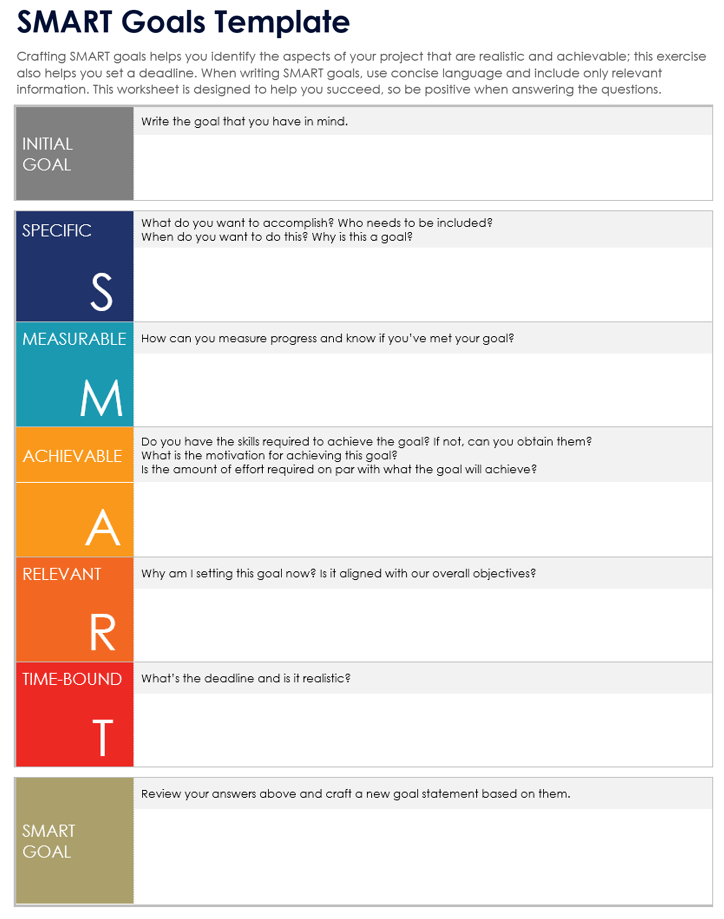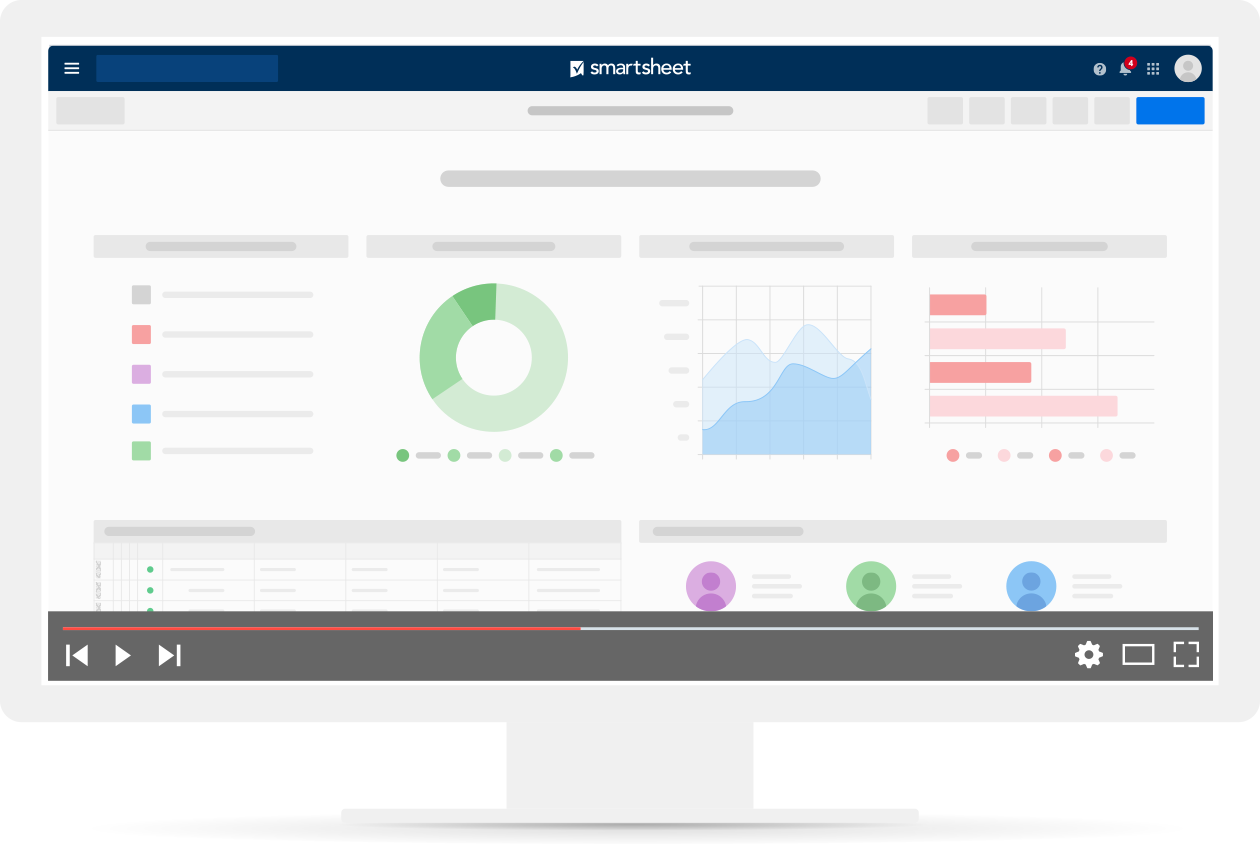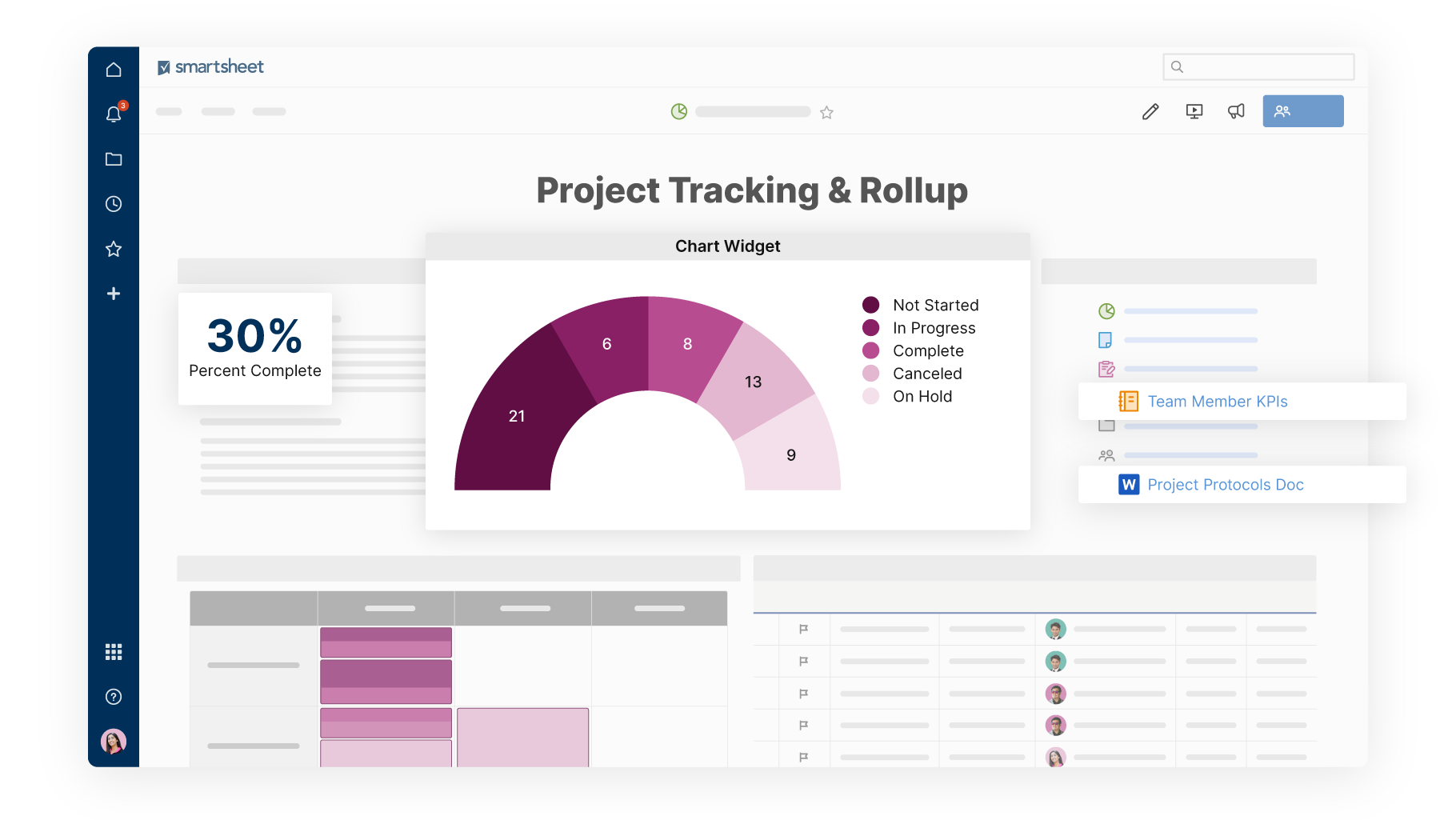What Is a SMART Goal?
A SMART goal is a framework for defining objectives, where each goal is specific, measurable, achievable, relevant, and time-bound (SMART). Follow this method to establish clear, attainable goals that hold you accountable to a deadline.
SMART goals are useful in all professional sectors and industries, as well as in personal life (see examples of personal and professional SMART goals below). Using this framework will help ensure that you are working toward clearly defined goals that you can execute by a deadline.
Additionally, the SMART framework eliminates guesswork and back-and-forth among parties. It also helps individuals and teams track progress with pre-defined success metrics.
Jake Munday is the Founder and CEO of Custom Neon, a company that creates custom signage. He says, “This framework ensures that objectives are not simply aspirational but also actionable by helping you create precise, manageable goals that can be tracked within a given timeframe.”
To learn more, read our comprehensive guide on the difference between SMART goals and a related framework, objectives and key results (OKRs).
See how Smartsheet can help you deliver on SMART goals
Smartsheet is a cloud-based platform that allows teams and organizations to plan, manage, and report on work, helping you move faster and achieve your goals. See Smartsheet in action.
How to Create a SMART Goal
| S | Specific | What do you want to accomplish? What specific outcome do you want to achieve? |
| M | Measurable | How will you measure your success? What type of data will you include? How will you evaluate it, and how frequently will you check? |
| A | Attainable | Do you have all the necessary skills and resources to achieve this goal? If not, can you obtain them? |
| R | Relevant | Is this goal aligned with your other goals, or the overarching goals of your team or organization? |
| T | Time-Bound | What is the timeframe for achieving this goal? |
To create a SMART goal, decide what you want to accomplish, and then address each component of the SMART acronym. Make sure that your goal centers on an outcome, not a practice or set of behaviors. A SMART goal should, in the end, achieve something.
Use the chart below to see if your goal meets the SMART criteria at a high level. For a more in-depth discussion of how to write SMART goals, see our step-by-step how-to below.
Though it’s important that you clearly define your goal using the method above, remember that it’s still worthwhile to brainstorm all your various ideas. Once you see all the potential options, work with your team to refine the list and create SMART goals.
“I like to brainstorm with my team about our overarching or more nebulous goals, and then turn those into SMART goals,” says Allison Schmidt, the Marketing Manager at Get Online NOLA. “For example, a more vague goal could be to increase sales this year or to grow a TikTok following. However, that doesn't set you up for success. But having a broad goal helps you to break that down into more specific pieces or your SMART goals.”
To turn Schmidt’s example into a SMART goal, you would simply run it through the chart above — or follow the in-depth how-to below — to make it actionable, concrete, and measurable.
How to Write SMART Goals
To write a SMART goal, simply define each component in the SMART acronym. Go in order, and ensure that your proposed goal is specific, measurable, attainable, relevant, and time-bound. If it doesn’t meet each of these criteria, slowly refine it until it does.
Follow the step-by-step how-to below for guidance on how to write and refine your goals to ensure that they are SMART.
S: Ensure Your Goal Is Specific
Think about this step as the mission statement for your goal. Focus on an outcome you want to achieve, not just a set of practices you want to implement. Be as specific as possible.
To do this, answer the five W questions (who, what, when, where, and why):
- Who: Consider who needs to be involved to achieve the goal. Consider appointing roles and responsibilities.
- What: Dive into the details of what you want to accomplish.
- When: Envision a general sense of the timeline you anticipate you’ll need to achieve this goal. You’ll have to be much more specific about this in the “T” section of the how-to.
- Where: This question may not always apply, especially if you’re setting personal goals, but if there’s a location or relevant event your goal is tied to, identify it here.
- Why: What is the reason for the goal? When it comes to using this method for employees, the answer will likely be along the lines of company advancement or career development.
“Define the goal as clearly as possible. Avoid vagueness which can lead to misdirection,” says Munday.
M: Decide How You Will Measure Your Goal
In this step, decide which metrics you will use to track your progress and to define whether or not you are successful. Doing so makes a goal more tangible because it provides a way to concretely measure progress. If your goal will take several months to complete, set some milestones tied to specific subtasks.
“Ensure that the goal can be quantified or a clear indicator of progress can be identified,” says Munday. If the goal can’t be quantified, you will need to adjust it.
A: Ensure Your Goal Is Attainable
“Your goal should be challenging yet attainable with the available resources,” continues Munday.
Look at the resources available to you — people, capital, tools, etc. — and assess whether this goal is realistic with your current means. You might also look at data on past projects to determine whether this new goal is attainable.
If not, that doesn’t mean you need to abandon your goal. Simply assess the costs of investing in additional resources, or consider extending your timeline in the time-bound section below.
R: Ensure That Your Goal Is Relevant to Larger Objectives
In this scenario, relevance refers to how well your goal aligns to larger team or organizational initiatives. Ideally, your goal will support the other work you’re doing and serve your long-term goals in some way. If nothing else, it should not detract or divert energy away from goals you’re already committed to.
T: Give Yourself a Time Limit for Accomplishing Your Goal
Setting a hard deadline will help you measure progress, even if you don’t accomplish your goal in the allotted time period.
Anyone can set goals, but if it lacks realistic timing, chances are you’re not going to succeed. Commit to a target date for deliverables, and ask all stakeholders whether this goal is likely to be completed in the allotted time period.
If the goal will take three months to complete, it’s useful to define what should be achieved halfway through the process. Providing time constraints also creates a sense of urgency.
Microsoft Word SMART Goals Worksheet

Download a SMART Goals Template for
Microsoft Word
| Google Docs
When to Use: Use this worksheet to brainstorm and refine your SMART goals. Start by making an extensive list of all possibilities, and then slowly edit and refine that list in order to draft your final SMART goal.
Notable Features: The template is broken out into sections for each letter in the acronym: specific, measurable, achievable, relevant, and time-bound. Each section includes prompts that will help you brainstorm all the variables that you need to take into account. Then, you can home in on your priorities and write your finalized SMART goals.
How to Pick the Right SMART Goals
The “right” SMART goals will be in line with larger team or organizational objectives. Don’t commit to any new goal that conflicts with or counteracts an existing goal. Instead, make sure all goals align and work together to achieve organizational success.
“To choose the right SMART goals, I first assess the overall objectives of the project or initiative,” says Munday of Custom Neon. “Understanding the end game allows me to reverse engineer the steps needed to get there, which I then shape into specific SMART goals. It’s crucial that each goal directly contributes to the larger objective to maintain coherence and focus throughout the project.”
Alex Ugarte, the Operations Manager at London Office Space, echoes this sentiment. “Ensure [your goals] align closely with broader ambitions,” he says. “This ensures that every effort directly supports your overarching aims, optimizing impact and resource use.”
One way to accomplish this is to look at the larger organizational goal and break it down into smaller, more manageable goals. This not only makes it less intimidating to get started but also brings the loftier goals out of the abstract and transforms them into concrete, actionable steps.
Execute on SMART Goals with Project Management in Smartsheet
Once you’ve defined your SMART goals, it’s essential to put a plan in place to achieve them. To help with execution, you need a tool that enables you to plan, track, manage, automate, and report on your goals in real-time.
One such tool is Smartsheet, a work execution platform that enables enterprises and teams to get from idea to impact - fast. With a collaborative, real-time objectives tracker in Smartsheet, you can increase transparency and improve accountability across your initiatives.
Get the Team Objectives Tracker for Free
Plus, top project management leaders rely on Smartsheet to help align the right people, resources, and schedules to get work done. Use Smartsheet to create consistent project elements, increase speed, and improve collaboration with scalable options that fit individual work preferences. Hold yourself and your team accountable, improve visibility into team priorities, and ensure nothing slips through the cracks.
Discover how Smartsheet can help maximize your project management efforts, today.
Examples of SMART Goals
You can write SMART goals for any professional setting or industry, as well as for your personal life. Below, you’ll find real-world examples of initiatives and how to format them as SMART goals.
Professional SMART Goal to Improve Employee Performance and Retention
Ritchie Tendencia, the CEO of CSV Now (Consult Silicon Valley Now), wanted to improve overall employee satisfaction and performance. That’s a great impulse, but as written, it wasn’t concrete enough — that is, SMART enough — to be achievable or impactful.
Tendencia then defined the parameters of his goal using the SMART framework. The SMART version of this goal is as follows:
I want to reduce employee turnover rates by at least 10 percent in the next quarter.
This specific, measureable, and time-bound goal led to an “increased employee satisfaction via a structured training program [that] led to a 15 percent reduction in turnover rates and improved client satisfaction,” says Tendencia. “[This demonstrates] the effectiveness of the SMART framework in driving meaningful outcomes.”
Professional SMART Goal to Decrease Customer Churn Rate
Axel Lavergne is the Founder of ReviewFlowz, a review and testimonial service for SaaS companies. He wanted to increase customer satisfaction and retention — in other words, to decrease customer churn. His team needed to define both the timeline of this objective and the success metrics.
We aim to reduce customer churn rate by 10 percent in six months.
Once Lavergne and his team had clear-cut metrics and a schedule to adhere to, he ended up exceeding his goal. “We achieved this by improving our onboarding process, offering more comprehensive training resources, and regularly checking in with new customers. This resulted in stronger customer relationships and a significant reduction in churn,” he says.
Personal SMART Goal to Become a Better Leader
Jake Munday of Custom Neon wanted to improve his leadership skills and become a stronger CEO. However, he needed to focus his efforts on something tangible so the goal could be measured and the necessary actions wouldn’t be so vague.
Here’s how he turned it into a SMART goal:
I want to complete a leadership development course in three months, by dedicating two hours every week to study.
“This goal was specific to professional growth, measurable by course completion, achievable within my weekly schedule, relevant to enhancing my leadership skills as a founder and CEO, and time-bound by a three-month period,” says Munday.
Personal SMART Goal to Increase My Business Knowledge
Lavergne of ReviewFlowz wanted to increase his business knowledge by reading more books but needed to concretize the goal. He followed the SMART formula and wrote the following SMART goal:
I will increase my business knowledge by reading one business book per month for a year.
“This goal was specific, measurable, achievable, relevant to my professional growth, and time-bound, helping me stay disciplined and informed,” says Lavergne. “It significantly broadened my knowledge and improved my business strategies, making me a more effective leader.”
For dozens more examples of SMART goals, visit our roundup of SMART goals and examples. Additionally, check out this comprehensive guide to project management SMART goals and these examples of SMART goals for leadership.
How to Track SMART Goals
It is imperative to track SMART goals to measure your progress and assess whether or not you were successful. Because SMART goals require you to define the metrics and timeframe of each goal up front, they are relatively easy to track and report on.
Below are some expert tips for tracking SMART goals:
- Ensure That the Goal Is Actually Measurable: “Make sure the goals you set out are actually measurable,” says Ugarte of London Office Space. “Have quantifiable criteria to track progress and determine when the goal has been achieved. For example, rather than aiming to ‘improve customer satisfaction,’ instead set a goal to ‘achieve a customer satisfaction score of 90 percent as measured by our end-of-service surveys.’"
- Stick to the Metrics You Defined Up Front: Part of defining a SMART goal is choosing how you will measure success. To effectively report on your performance, don’t change these metrics midway through.
- Set Up a Tracking System: Use project management software or another goal-tracking program to monitor your progress. This ensures that you have a single source of truth for all team members to refer to and will help keep you accountable to your goals. Visit our complete roundup of goal tracking templates to get started tracking your progress.
- Consistently Evaluate Your Progress: Decide how frequently you will track progress. Don’t refer to your metrics so often that it becomes its own source of stress (i.e. every day), but check often enough that you are looped into any unanticipated hangups. Consistently monitoring progress will allow you to communicate and collaborate early if things go off course.
- Celebrate Every Win: “Make sure you celebrate once the goal's been hit,” says Logan Mallory, VP of Marketing at Motivosity, “recognizing that hard work, energy, and commitment is how you keep folks motivated, preventing future goals from feeling like a thankless hamster wheel.”
- Reflect on and Learn from Each Round of Goals: Even if you fall short of a goal, it’s worth reflecting on it with the team. What went well, and what could have gone better? Bring those new insights to your next round of goals, and adjust criteria — such as time or resources — to hit your new goals.
- Don’t Be Afraid to Reassess and Edit Your SMART Goals: “I always make sure I've got a few sessions scheduled across a week or two to revisit my SMART goals before finalizing them,” says Mallory of Motivosity. “SMART goals are like any rough draft. The very first stab at it probably won't be the best or most elegant. Give yourself time to play around with the goals, revisiting their clarity and details and really leaving space for final tweaks.”
Establishing Clarity Around Success and Failure of Goals
Empower your people to go above and beyond with a flexible platform designed to match the needs of your team — and adapt as those needs change.
The Smartsheet platform makes it easy to plan, capture, manage, and report on work from anywhere, helping your team be more effective and get more done. Report on key metrics and get real-time visibility into work as it happens with roll-up reports, dashboards, and automated workflows built to keep your team connected and informed.
When teams have clarity into the work getting done, there’s no telling how much more they can accomplish in the same amount of time. Try Smartsheet for free, today.







